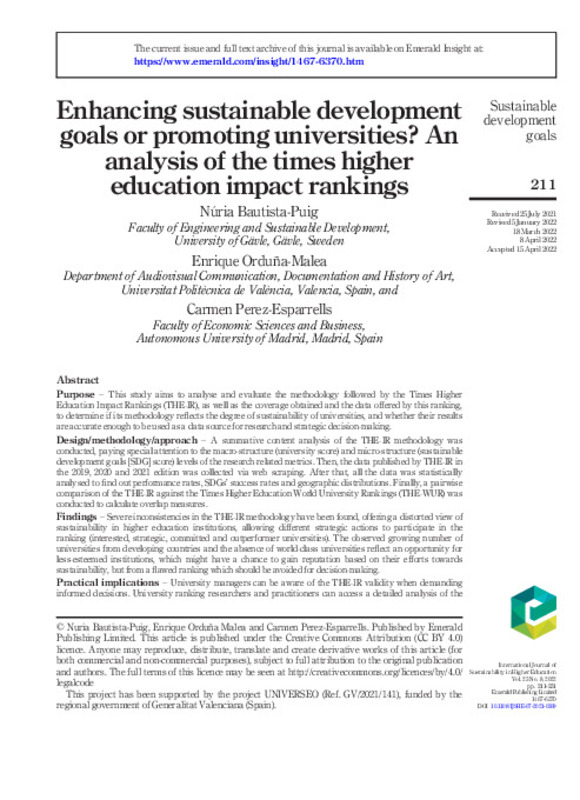|
Resumen:
|
[EN] Purpose This study aims to analyse and evaluate the methodology followed by the Times Higher Education Impact Rankings (THE-IR), as well as the coverage obtained and the data offered by this ranking, to determine if ...[+]
[EN] Purpose This study aims to analyse and evaluate the methodology followed by the Times Higher Education Impact Rankings (THE-IR), as well as the coverage obtained and the data offered by this ranking, to determine if its methodology reflects the degree of sustainability of universities, and whether their results are accurate enough to be used as a data source for research and strategic decision-making. Design/methodology/approach A summative content analysis of the THE-IR methodology was conducted, paying special attention to the macro-structure (university score) and micro-structure (sustainable development goals [SDG] score) levels of the research-related metrics. Then, the data published by THE-IR in the 2019, 2020 and 2021 edition was collected via web scraping. After that, all the data was statistically analysed to find out performance rates, SDGs' success rates and geographic distributions. Finally, a pairwise comparison of the THE-IR against the Times Higher Education World University Rankings (THE-WUR) was conducted to calculate overlap measures. Findings Severe inconsistencies in the THE-IR methodology have been found, offering a distorted view of sustainability in higher education institutions, allowing different strategic actions to participate in the ranking (interested, strategic, committed and outperformer universities). The observed growing number of universities from developing countries and the absence of world-class universities reflect an opportunity for less-esteemed institutions, which might have a chance to gain reputation based on their efforts towards sustainability, but from a flawed ranking which should be avoided for decision-making. Practical implications University managers can be aware of the THE-IR validity when demanding informed decisions. University ranking researchers and practitioners can access a detailed analysis of the THE-IR to determine its properties as a ranking and use raw data from THE-IR in other studies or reports. Policy makers can use the main findings of this work to avoid misinterpretations when developing public policies related to the evaluation of the contribution of universities to the SDGs. Otherwise, these results can help the ranking publisher to improve some of the inconsistencies found in this study. Social implications Given the global audience of the THE-IR, this work contributes to minimising the distorted vision that the THE-IR projects about sustainability in higher education institutions, and alerts governments, higher education bodies and policy makers to take precautions when making decisions based on this ranking. Originality/value To the best of the authors' knowledge, this contribution is the first providing an analysis of the THE-IR's methodology. The faults in the methodology, the coverage at the country-level and the overlap between THE-IR and THE-WUR have unveiled the existence of specific strategies in the participation of universities, of interest both for experts in university rankings and SDGs.
[-]
|









